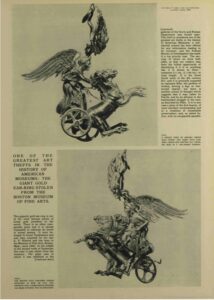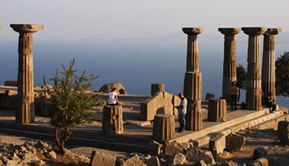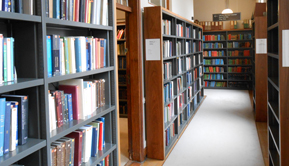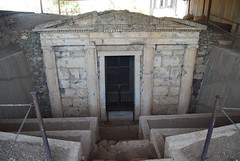Greek Art Heists
In the wake of Athens’s ‘heist of the century’ Alice Dunn learns that, unfortunately, there are several runners up to that accolade, as reported vividly in the history of the press

The ‘gigantic gold earring’ featured in the Illustrated London News, 5 October 1963
(© Illustrated London News)
At the time of penning this piece, the man accused of the so-called ‘heist of the century’ has been released from pre-trial detention following arrest last year for stealing three paintings, including works by Picasso and Mondrian, from the National Museum in Athens in 2012. Greece and its antiquities long been targeted by thieves – I am not describing here the dispute over the Parthenon Marbles – resulting in some of the most extraordinary tales nestled in newspaper archives.
In 1888, the London correspondent of the Liverpool Daily Post reported the story of the British Museum’s acquisition of a ‘magnificent marble bust’ of the Emperor Hadrian, which had been purchased for an ‘exceedingly reasonable’ price. Thrilled with their new addition, the museum curators invited a Greek gentleman with close connections to the diplomatic world to see the treasure. It did not go according to plan, for ‘as soon as he set eyes on the bust, [he] recognised in it one of the most valuable treasures of the Royal Museum at Athens.’ The bust of Hadrian had been stolen. What was more, the museum in Athens then learned that other priceless treasures had also vanished.
Some stories revel in thieves’ failure to recognise what they are handling. Take the account filed under ‘Work of an Ordinary Thief’ from the Dundee Courier in 1926. Thirty-four ancient Greek and Roman coins were stolen from the Victoria and Albert Museum, apparently for the purpose of melting down. In a bid to goad the criminal who took the coins, the article points out that: ‘These gold coins were among the least valuable things in the case.’ If the thief read on, they would have learned that they inadvertently: ‘ignored a number of silver coins in the same case which are unique and irreplaceable.’ This is followed by a warning. The coins’ value as liquid gold would be ‘almost £100; their value as antiques would run into hundreds of pounds.’ If that perked up the guilty party, a chill may have followed. The thief apparently left behind ‘some excellent finger-prints on the inner piece of glass, and the police, having brought them up by means of their special powder-blowing apparatus, are now comparing them with those filed in the Criminal Record Office.’
A 33-year-old clerk confessed days later, saying that while he was busy pocketing the coins, ‘the officer in charge of the room passed me on four different occasions.’ He compounded his description of the inadequacy of museum security by adding: ‘It was the work of a moment to lift the glass and take the coins. I walked out of the Museum like any other person, undetected.’ The following month, the case was heard at the Old Bailey, and the clerk’s plight and decision to go straight was hearteningly divulged, only for him to be sentenced to three years’ penal servitude.
Poor security measures could be blamed for a theft in 2002, when a Greek statue worth up to £50,000 was stolen from under the noses of security staff at the British Museum. The thief was thought to have removed the 7-inch bust dating from the 6th century BC by popping it into his pocket before leaving. Fortunately, lessons were learned. Within a couple of years, the British Museum was briefly locked down during an attempted theft in the Greek and Roman rooms, when a guard happened to notice a man using pliers to prise open a display cabinet.
A lockdown may not have helped in 1967 when a £500,000 theft at the National Archaeological Museum of Athens was undertaken by an employee (who would have had full knowledge of any secret passageways). Thirty-four exhibits and 50 ancient coins were taken by the 56-year-old designer who had spent the past 25 years working in the pottery mending workshop of the museum. He confessed to being an old hand, ‘stealing antiquities since 1954.’ His hoard included bronzes, pottery and coins, a rare sixth-century BC bronze statuette of a ram-bearing Hermes, and a unique round ivory seal from Sparta from the same period. The Times article states that writs were issued in Kavalla for the arrest of two men who were assisting the museum employee to sell the antiquities to tourists.
In a surprising twist, it was the museums of Basel and West Berlin who first discovered the thefts when three bronze statuettes catalogued as being exhibits of the Athens museum turned up in those cities. These objects were an Arcadian hoplite holding a sword; a calf-bearing shepherd from Olympia; and a statuette of the goddess Hera, which was found when a German tourist asked the museum of West Berlin to evaluate his £900 purchase from Kavalla.
To save on column inches, another theft was mentioned in the same article. A gang had apparently broken into the museum of Volos in central Greece taking ‘most of its collection’, including 115 ancient statuettes, and 720 rare silver and bronze coins. Four men were arrested and led the police to a forest near Athens where the haul had been buried until it could be smuggled out. Readers were reassured that security and archaeological authorities were meeting to discuss improving theft precautions.
Indeed, it is often the tale of the discovery of a loot that steals the headlines. In the year 2000, a decade after the Museum of Ancient Corinth was emptied of over 270 treasures in a violent robbery, the bulk of the collection was found when crates of fresh fish were seized from a warehouse in Miami. The antiquities were believed to be worth more than £200 million.
Among the objects were a 5th-century BC kouros head, 164 urns and jugs – ‘exquisite examples from the Corinthian and Attic workshops’ – a statue of Aphrodite and Eros (600–479 BC) and a marble statue of Pan. Other sculptures included a delicate portrait of a noblewoman which dated from the 1st to 2nd century, five terracotta heads dated to the 5th or 6th century BC, 49 terracotta figurines, 11 glass vessels, two small bronze statues, and terracotta oil lamps. An antiquities specialist singled out a ceramic vessel decorated with a cockerel and a swan from the mid-6th century BC, telling The Times that it was ‘typical of what was produced in Corinth. They were the primary exporters of decorated ceramics in the Greek world.’ He added: ‘The marble head of a kouros is also an important piece. It dates to around 20 to 40 years before the Parthenon was rebuilt as it stands now.’
Of course, thefts are not exclusive to museums. In 2001 Greek police began a search for seven marble statuettes missing from the tomb of Alexander the Great’s grandmother. The loss was discovered by an archaeologist taking government officials on a tour of the Macedonian royal tombs. One can only imagine the awkward conversation that followed.
Other stories relish the newsworthy combination of knowledgeable thieves with ample opportunity for robbery. In 1981 The Times shared the story of a university history lecturer who took it upon himself to ‘build a perfect collection of rare Greek coins’ by ‘systematically stealing’ from museums such as the Ashmolean Museum, Liverpool University and Liverpool city museum. He was given hundreds of uncatalogued Greek, Roman and Byzantine coins to sort through at Liverpool University, and the value of the coins from various museums ran to tens of thousands of pounds, the jury heard.
Unbelievably, The Times ran a similar story seven years later. A thief with a penchant for paintings and antiques valued at £700,000 had turned his house into a museum. For eight years, this 44-year-old former teacher walked around London galleries ‘helping himself to whatever he fancied.’ He stole £85,000 worth of Greek and Roman artefacts, including a brass statue of Atlas and a marble angel.
Police were baffled as to how he managed to bypass security systems (although by now we know it may not have been as difficult as it should have been). The prosecution declared: ‘All we know is that he used the pseudonym ‘Arnold’ in his dealings with the galleries.’ The vivid takeaway image was of the police entering the accused’s house and finding 2,300 valuable stolen items. The prosecution was confident that had the accused ‘made people pay to have a look around his house I am sure they would have felt they got their money’s worth.’ The ex-teacher was sentenced to four years in jail.
When the Illustrated London News reported the theft of a Greek gold earring from the Boston Museum of Fine Arts in 1963, they called it: ‘One of the Greatest Art Thefts in the History of American Museums.’ The ‘gigantic gold ear-ring is one of the most famous pieces of Greek gold jewellery in the world,’ the report said. Its worth was impossible to estimate. The story was allocated a full page, complete with two generous images of the gold earring from two angles, ‘so that our readers may have the fullest opportunity of identifying it if it or anything like it is shown to them.’
Optimists with dreams of seeing the earring first hand would at least appreciate its significance. The article states that the earring was ‘the finest Greek work of the 4th century BC and it is generally supposed to represent Nike, the goddess of victory, driving a biga or two-horsed chariot.’ The journalist confesses that identifying pieces with any certainty can be tricky as: ‘there is another school of thought which suggests that it may rather be Psyche and be an allusion to the heavenward struggle of the soul, as described by Plato.’ Regardless, ‘it is in any case a piece of the first beauty, of most excellent workmanship and in a condition of remarkable preservation.’
Fortunately, the same could be said when it was found, six months later, ‘in part of an egg carton, inside a tin can, buried on the banks of the Muddy River, not far from the Museum.’ A search party headed by Professor Emily Vermeule, a famed American classical scholar, found the piece. If only that astute search party had been at the fore of the security department of any museum.









